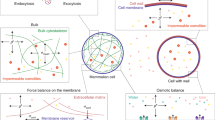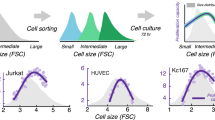Abstract
THE understanding of the control of cell proliferation and differentiation requires the unravelling of the early events that trigger the initiation of growth. An in vitro system to study the initiation of growth is provided by the mouse 3T3 cell line. These cells exist in two alternative growth states: either reversibly arrested in the G0 phase of the cell cycle or in active proliferation. When resting 3T3 cells are exposed to fresh serum they recommence DNA synthesis and cell division1. Functional membrane changes are among the earliest events associated with the reinitiation of growth2. Within minutes of serum addition, the rate of transport of inorganic phosphate, nucleosides and glucose is increased several fold2–6, while cyclic AMP, which has been implicated in the regulation of growth of cultured fibroblasts, shows an opposite change7–11.
This is a preview of subscription content, access via your institution
Access options
Subscribe to this journal
Receive 51 print issues and online access
$199.00 per year
only $3.90 per issue
Buy this article
- Purchase on Springer Link
- Instant access to full article PDF
Prices may be subject to local taxes which are calculated during checkout
Similar content being viewed by others
References
Todaro, G. J., Matsuija, Y., Bloom, S., Robbins, A., and Green, H., in Growth Regulating Substances for Animal Cells in Culture (edit. by Defendi, V., and Stoker, M.), 87–98 (Wistar Institute Press, 1967).
Pardee, A. B., and Rozengurt, E., in Biochemistry of Cell Walls and Membranes (edit. by Fox, C. F.), (Medical and Technical Publishing Company, London, in the press).
Cunningham, D. D., and Pardee, A. B., Proc. natn. Acad. Sci. U.S.A., 64, 1049–1056 (1969).
Grimes, W. J., and Schroeder, J. L., J. Cell Biol., 56, 487–491 (1973).
Kram, R., Mamont, P., and Tomkins, G. M., Proc. natn. Acad. Sci. U.S.A., 70, 1432–1436 (1973).
Bradley, W. E. C., and Culp, L. A., Expl Cell Res., 84, 335–350 (1974).
Otten, J., Johnson, G. S., and Pastan, I., J. biol. Chem., 247, 7082–7087 (1972).
Sheppard, J. R., Nature new Biol., 236, 14–16 (1972).
Burger, M. M., Bombik, B. M., Breckenridge, B. M., and Sheppard, J. R., Nature new Biol., 239, 161–163 (1972).
Rozengurt, E., and Jimenez de Asua, L., Proc. natn. Acad. Sci. U.S.A., 70, 3609–3612 (1973).
Jimenez de Asua, L., Rozengurt, E., and Dulbecco, R., Proc. natn. Acad. Sci. U.S.A., 71, 96–98 (1974).
Hershko, A., Hamont, P., Shields, R., and Tomkins, G. M., Nature new Biol., 232, 206–211 (1971).
Pardee, A. B., Jimenez de Asua, L., and Rozengurt, E., in Control of Proliferation in Animal Cells (edit. by Clarkson, B., and Baserga, R.), 547–561 (Cold Spring Harbor Laboratory, 1974).
Kram, R., and Tomkins, G. M., Proc. natn. Acad. Sci. U.S.A., 70, 1659–1663 (1973).
Chasin, M., Harris, D. N., Phillips, M. B., Hess, S. M., Biochem. Pharmac., 21, 2443–2450 (1972).
Illiano, G., Tell, G. P. E., Siegel, M. I., and Cuatrecasas, P., Proc. natn. Acad. Sci. U.S.A., 70, 2443–2447 (1973).
Author information
Authors and Affiliations
Rights and permissions
About this article
Cite this article
DE ASUA, L., ROZENGURT, E. Multiple control mechanisms underlie initiation of growth in animal cells. Nature 251, 624–626 (1974). https://doi.org/10.1038/251624a0
Received:
Revised:
Issue Date:
DOI: https://doi.org/10.1038/251624a0
This article is cited by
-
Enhancement of Glucose transport in clone 9 cells by exposure to alkaline pH: Studies on potential mechanisms
The Journal of Membrane Biology (1991)
-
Regulation of uridine kinase activity in BLAB/C-3T3 cells by serum components
In Vitro (1981)
-
Phorbol esters and vasopressin stimulate DNA synthesis by a common mechanism
Nature (1980)
-
Uptake of nucleosides in density-inhibited cultures of 3T3 cells
Nature (1977)
-
Interaction of two hormones and their effect on observed rate of initiation of DNA synthesis in 3T3 cells
Nature (1977)
Comments
By submitting a comment you agree to abide by our Terms and Community Guidelines. If you find something abusive or that does not comply with our terms or guidelines please flag it as inappropriate.



